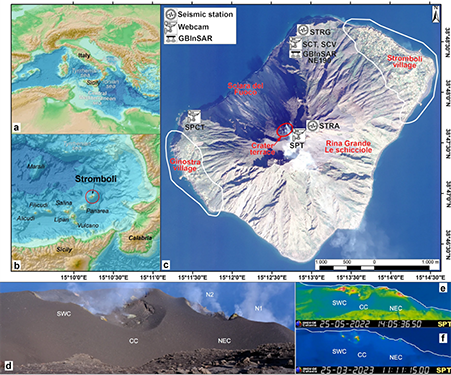Generation of deposit-derived pyroclastic density currents by repeated crater rim failures at Stromboli Volcano (Italy)

Di Traglia F., P. Berardino, L. Borselli, P. Calabria, S. Calvari, D. Casalbore, N. Casagli, F. Casu, F. Latino Chiocci, R. Civico, W. De Cesare, C. De Luca, M. Del Soldato, A. Esposito, C. Esposito, M. Favalli, A. Fornaciai, F. Giudicepietro, T. Gracchi, R. Lanari, G. Macedonio, F. Monterroso, A. Natale, T. Nolesini, S. Perna, T. Ricci, C. Romagnoli, G. Rossi, C. Tacconi Stefanelli (2024).
Bulletin of Volcanology, 86, 69. https://doi.org/10.1007/s00445-024-01761-5
Abstract
The gravitational instability of hot material deposited during eruptive activity can lead to the formation of glowing avalanches, commonly known as deposit-derived pyroclastic density currents (PDCs). These currents can travel hundreds of metres to several kilometres from the source at exceptionally high temperatures, posing a catastrophic hazard to areas surrounding steep-slope volcanoes. The occurrence of deposit-derived PDCs is often associated with crater rim failure, which can be triggered by various factors such as magma thrust from dike injection, magma fingering, bulging or less commonly, powerful explosions. Here, the in-depth study of data from the multi-parametric monitoring network operating on Stromboli (Italy), including video surveillance, seismicity and ground deformation data, complemented by remote topographic sensing data, has facilitated the understanding of the events leading to the crater rim collapse on 9 October and 4 December 2022. The failures resulted in the remobilisation of 6.4 ± 1.0 × 103 m3 and 88.9 ± 26.7 × 103 m3 of material for the 9 October and the 4 December 2022, respectively, which propagated as PDCs along the NW side of the volcano and reached the sea in a few tens of seconds. These events were characterised by a preparatory phase marked by an increase in magmatic pressure in the preceding weeks, which correlated with an increase in the displacement rate of the volcano’s summit. There was also an escalation in explosive degassing, evidenced by spattering accompanied by seismic tremors in the hours before the collapse.
These events have been interpreted as an initial increase in magma vesicularity, followed by the release of gas once percolation threshold was reached. The degassing process induced densification of the magma, resulting in increased thrust on the conduit walls due to increased magmastatic pressure. This phase coincided with crater rim collapse, often followed or accompanied by the onset of lava overflow phases. A mechanism similar to the one proposed may shed light on similar phenomena observed at other volcanoes. The analysis performed in this study highlights the need for a multi-parametric and multi-platform approach to fully understand such complex phenomena. By integrating different data sources, including seismic, deformation and remote sensing data, it is possible to identify the phenomena associated with the different phases leading to crater rim collapse and the subsequent development of deposit-derived PDCs.



Devi effettuare l'accesso per postare un commento.